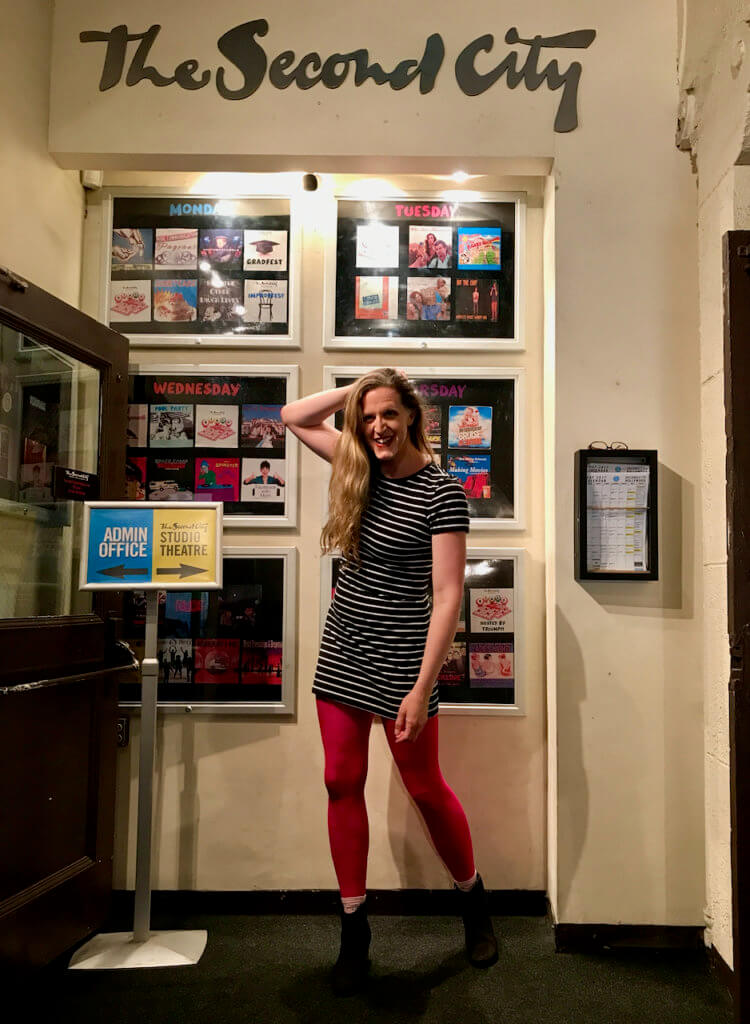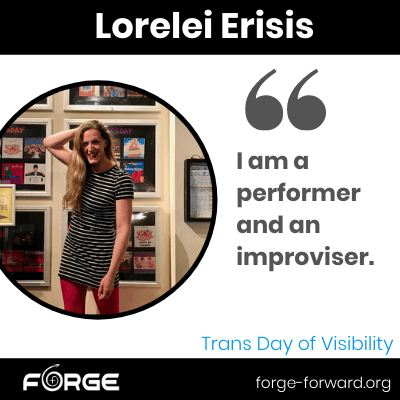By Lorelei Erisis
With the Trans Day of Visibility fast approaching (possibly even here and gone by the time you read these words) I have been thinking around the idea of being seen. What does it mean to be seen, as a trans person, as a woman, as me?
This is hardly a new idea for me to think about. In one way or another, the idea of being “seen” and what that means has been something I’ve been thinking about my whole life. Quite aside from being a trans woman, I am a performer and an improviser.
Improv is the thing I love more than any other pursuit I have found in my increasingly and unexpectedly long life. If you were to meet me, and ask me about improv, I WILL HAVE THINGS TO SAY. I will gladly talk about improv with anyone who is interested, for hours and hours. I will even more gladly do improv!
Where my desire to perform came from is nearly as mysterious as what makes me trans. But several clear factors definitely encouraged it.
On the one hand, I was an only child with divorced parents who both worked. And though they were as loving and attentive as they had the time and energy to be, I was alone quite a lot of the time. It was the 70s and 80s, a time when it was not uncommon just to leave kids to fend for themselves and hope for the best.
We also moved around quite a bit, and I was tall, awkward and usually had my face in a book. I didn’t have very many friends. And the adults didn’t have too much time to pay attention to me. In that sense, I was not much seen by people I very much wanted to see me.
On the other hand, because I was quite tall, and almost commensurately awkward; I got teased a lot by every bully who wanted to prove how tough they were by picking on the weird, tall kid. Additionally, and to this day, people, sometimes even strangers in the street, made a habit of informing me, quite bluntly of just how tall I was. As if I somehow hadn’t noticed. It’s a strange impulse I have never quite understood.
These people, I often wished would not see me. Not at all.
And of course, alongside all this, I was trans, and trying to figure out what that meant. But also pretty sure it was not something I wanted people to know. Or that I thought would go very well for me if they did. Heck, kids already routinely bullied me to tears over something so mundanely common as being tall. And because I’m from Massachusetts and it was the 70s/80s the usual insult was to call me “f*g” often modified as, “big f*g”.
Given all this, I did my absolute best to keep my transness hidden. To make sure no one saw the girl I actually was.
Though in one respect, I conform to the archetypal template of a trans woman who has, “always known I was a girl”. In other respects, I broke far away from the archetype. Instead of trying harder to, “fit in” and be like “all the other guys”; instead of trying to make myself seem more traditionally “masculine” and playing sports or aiming myself at a career in the military, or some other such pursuit. I opted to distract from my transness by entirely amping up what people perceived as my weirdness.
I had learned by my experience of trying to be seen by some people and not seen by others, to be quite adept at the whole business of how to get people’s attention and what to do with it once I had it. And I figured the best way to get people not to see what I didn’t want them to see (my transness) was to make them look the other way. To distract their attention with a big show and with unusual choices.
Nobody was going to guess I was trans and a woman, because they were too busy wondering why I was wearing my bathrobe and combat boots to school (and carrying a teacup). Or just exactly what had possessed me to dress up as Jesus Christ after I was told that wearing my bathrobe was, “disturbing the learning process.”
The bullies were speechless and a little scared. Everyone else was fascinated. My affectations were so odd and away from the norm, and the spectacle so hard to see past, that no one even considered my gender might not be what I said it was; and my parents entirely failed to notice I was getting dressed up like a girl whenever no one else was home.
And at some point in the midst of all this, just barely in my teens, I was introduced to improv. A staff member at the summer camp I went to for years, Rowe Camp and Conference Center, who was coincidentally one of the first Out gay men I knew, had us a play a couple of basic improv games in a theatre workshop he ran. And I was hooked, immediately. Absolutely infatuated with this remarkable form, this delightful discipline.
When I returned from camp that summer, I taught what I remembered of the games to my equally geeky best friend. And we played those games at every gathering and every party we had with our small, but close circle of also pretty wonderfully geeky friends.
Now, if you’re trans, or an actor, or especially, both, you can fill in a lot the blanks yourself for the ensuing years. There were repeated cycles of me desperately trying to accept and then brutally denying my transness. All while distractedly pursuing a career as an actor.
I say, “distractedly” because a large component of my not-dealing-especially-well with my trans identity and not-very-well-hidden gender, was by making lots of strange choices that were downright debauched, definitely dangerous, often illegal, absolutely adventurous and very likely to get me killed rather sooner than later. Which of course made it pretty hard to focus on finding the success I wanted as an actor.
Not that it stopped me. Or quelled in any way my desire to perform and my need to be seen.
For the purposes of this story I’m telling you now though, and in deference to my often harried and superhumanly patient editor, I’m going to skip over the vast bulk of that to jump forward several decades to a 33 year old and somehow still alive me, in Los Angeles. Trying harder than ever to just hold it together and pretend to be a man.
Yet somehow, through all the years, the gallons of alcohol, the strange drugs, the deep darkness, the dangerous choices, and everything else that went along with those things; my absolute love of improv and my joy in performance remained. And so, somehow, I found myself still alive and surprisingly unscathed, at the Hollywood outpost of the famous improv and sketch comedy theatre, The Second City.
 I had just graduated from the Conservatory Program at Second City and I was performing weekly with a group of fellow graduates doing long-form improv. We were inventing our own improv forms to perform and explore. Doing the work and playing. Saying, “Yes, And” to each other and making a commitment in every rehearsal and in every show to be there for each other and to support each other no matter what happened or what choices we made on stage.
I had just graduated from the Conservatory Program at Second City and I was performing weekly with a group of fellow graduates doing long-form improv. We were inventing our own improv forms to perform and explore. Doing the work and playing. Saying, “Yes, And” to each other and making a commitment in every rehearsal and in every show to be there for each other and to support each other no matter what happened or what choices we made on stage.
I loved every single second of it. Even and especially the really terrifying moments when I was farthest out on the edge and taking the biggest risks in performance, but doing so in the service of creating something wonderful and True.
But still, I was hiding who I was, what I was. I still playing the by then well-honed game of sleight of hand to distract people from really seeing me and in doing so knowing I was a woman. On stage, that translated to big characters and funny voices. “Wacky” and often funny, but ultimately inauthentic.
Improv, at least the style of improv I had been studying intensely, when it’s at it’s best and most pure is about nothing more or less than capital-T Truth. That’s where the connection is. Where the strongest scenes and the best comedy comes from.
And I was not getting there. Though I was trying, and I was dancing right up close to it every night.
Fortunately, I had a director at that time, David Razowsky, who was pushing me in just exactly the right ways. Whenever I was onstage in rehearsals, he would stop every scene I was in and give me the direction to, “play myself”. No matter what character I was playing, or who I was in a scene, he wanted to see me put my authentic self into the character, to build, to play from that bedrock of Truth.
I have honestly no idea if he had any idea of what exactly he was doing beyond giving me good improv advice. But the effect was that he was loading dynamite into the already large cracks that were developing in the “man” facade I had built up and had been hiding behind for so many years.
And when I realized that if I wanted to do this thing I loved, improv; if I wanted to be really good at it, I was going to have light the fuse on that load of dynamite and blow the whole building down.
I was going to have to finally allow myself to be seen. Simply. Honestly. Truly.
And that’s exactly what I did. I accepted myself, came out, and told everyone who would listen (and I am very good at getting people to listen) that I am a woman. And I am trans.
Of course, any of us who have been through our own journeys of transness know there is some simplification to this story. There is much complexity hidden in the details. But the basic Truth is here. And it was that seed of joy that improv kept alive in me that allowed me to find that Truth when I was finally ready to. And taught me to take the risks that most scared me in the service of that Truth.
I decided to say, “Yes” to being seen as the trans woman I am. I have never regretted making that choice. “And” I have worked many years since to do everything I can to help make it easier for other trans folks to find and safely express their own Truth to be seen as just exactly who they are.
Learn more about Lorelei:
Instagram: https://www.instagram.com/loreleierisis/
Twitter: https://twitter.com/Erisis
Blog: TransProviser https://transprov.wordpress.com
My column: Ask A Trans Woman http://www.therainbowtimesmass.com
To see other contributions to FORGE’s #TransDayOfVisibility collection, check out: https://forge-forward.org/collections/tdov/

